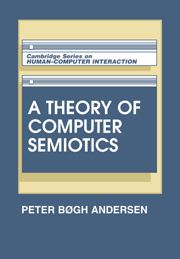 A Theory of Computer Semiotics
A Theory of Computer Semiotics I.2 - Adapting and extending structuralist methods
Published online by Cambridge University Press: 26 March 2010
Summary
We have now looked at work language, the language variety that must be central to our concerns, and made a preliminary list of the descriptive shortcomings of classical structuralism with respect to this language type.
In the next, constructive sections I will describe those parts of the tradition I wish to keep, and propose changes in other parts that make the theory better suited for the purposes at hand. Although the next few sections are concerned with language proper, I shall append short indications of how the concepts described can be used to understand computer systems, so that readers primarily interested in computers may judge if reading on is still worth the effort.
After presenting the key concepts (Section I.2.1), I show in Section I.2.2 how they can be applied to analysis of work processes and organizations, in particular the car repair and the Postal Giro examples from I.1.
Section I.2.3 extends the framework further to deal with computer systems. Computer systems are interpreted as media for human communication, and as a consequence of this, the theoretical focus is shifted from the system itself to the relations between system and user (Section I.2.4).
Basic concepts for describing symbolic acts
One of the basic points of structuralism is that units of language are defined relationally.
Instead of pre-existing ideas then, we find in all the foregoing examples values emanating from the system. When they are said to correspond to concepts, it is understood that the concepts are purely differential and defined not by their positive content but negatively by their relations with the other terms in the system. […]
Information
- Type
- Chapter
- Information
- A Theory of Computer SemioticsSemiotic Approaches to Construction and Assessment of Computer Systems, pp. 75 - 188Publisher: Cambridge University PressPrint publication year: 1991